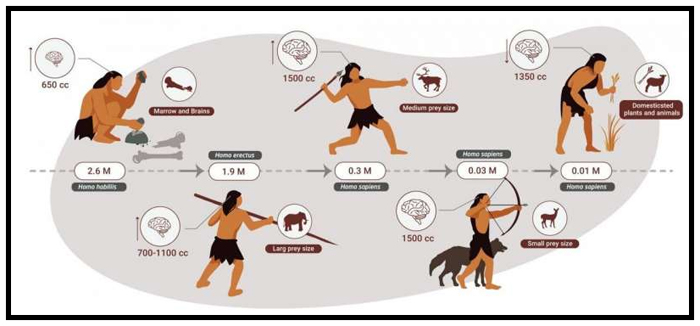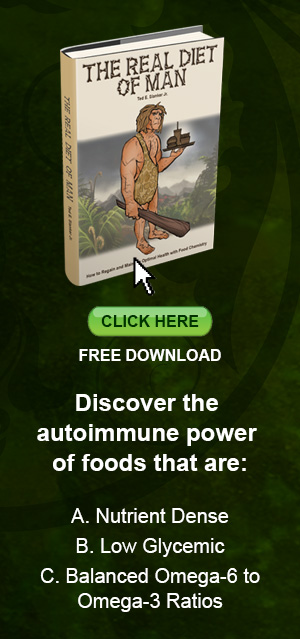Were Humans Ever Apex Predators?
Column #293 April 16, 2021
The best way to determine the nutritional requirements of humans is to analyze the human trophic level (HTL) during the Pleistocene age. The Pleistocene period (also known as the Ice Age) is the geological epoch that lasted from about 2,580,000 to 11,700 years ago. That 2.5-million-year-period ended when man invented farming and started to have an impact on the environment.1
For perspective, the Triassic, Jurassic, and Cretaceous periods (the ages of dinosaurs), lasted from 237 to 66 million years ago. The age of dinosaurs ended at the end of the Cretaceous period when a huge space object struck the Yucatan Peninsula. Its impact caused the entire world to quake convulsively, created a mile-high tsunami that traveled around the world, numerous volcanoes erupted at once, and the dust raised by the impact and erupting volcanoes blotted out the sun causing most vegetation to die out almost immediately. Temperatures plunged. That quickly caused a worldwide die off of dinosaurs that cleared the way for the evolution and adaptation of the dinosaurs' successors, the mammals, during the ensuing Tertiary period.2
The “trophic level” of an organism is its food chain ranking. The first trophic level consists of green plants which are considered primary producers. Herbivores are level two, carnivores are three or slightly higher, and apex predators are level four or five. Herbivores eat plants. Carnivores eat herbivores, plants, and are scavengers. Apex predators eat all animals, but rarely eat plants, and do not have natural predators. Examples of apex predators during the Pleistocene age include lions, tigers, and . . . humans.3 4
Last Saturday Kevin Stock highlighted an article from “The Times of Israel” that announced a newly published report by Tel Aviv University researchers titled: “The Evolution of the Human Trophic Level During the Pleistocene.” He commented that: “Animals of a particular species eat a similar diet. For example, there are not some lions that eat meat and others that graze on grass. Animals have ‘species-appropriate’ diets, which are congruent with their design. While eating a carnivore diet (for humans) seems strange in today's culture, Israeli researchers just published research using genetics, biochemistry, physiology, morphology, and archaeology to compile overwhelming evidence that for two million years humans ate meat and little else.”5 6
The comprehensive study he referred to should be of interest to everyone who is focused on optimizing their personal health and well-being. It states flat-out that for humans: “Animal foods are not only qualitatively but also quantitatively superior to plant foods, as determined by measures of nutrient density.” That means natural meats are healthier than plant-based foods for being low glycemic, packed solid with diverse and properly balanced nutrients, with also perfectly balanced Omega-6 to Omega-3 essential fatty acids (EFAs).
The study puts into question the theories about prehistoric humans being omnivores with eating habits comparable to modern-era humans. The lead author of the study, Dr. Ben-Dor, explained why we can’t compare 20th century hunter-gatherer societies with stone-age humans. "This comparison is futile, however, because two million years ago hunter-gatherer societies could hunt and consume elephants and other large animals—while today's hunter gatherers do not have access to such bounty. The entire ecosystem has changed, and conditions cannot be compared. We decided to use other methods to reconstruct the diet of stone-age humans: to examine the memory preserved in our own bodies, our metabolism, genetics and physical build. Human behavior changes rapidly, but evolution is slow. The body remembers."
Bodies do remember. It’s in their DNA. Technology, tools, and toys have changed, but people are basically the same in all respects. There are many features of modern humans that are indicative of our apex predator past.
I’ll mention just a few. There is the acidity of human stomachs, which is higher than omnivores and even some predators, and it requires a large amount of energy as does our large brains. That level of energy dependence is evidence for consuming animal products—especially fat. In omnivores, fat is stored in a relatively small number of large fat cells. In predators, including humans, there’s a much larger number of smaller fat cells. Other evidence of humans as predators is in our genome. For example, geneticists say that areas of the human genome were closed off to enable a fat-rich diet, while in chimpanzees, those areas were open to enable a sugar-rich diet.7
To get more energy, prehistoric man sought out fat which is why he hunted the largest animals. In campsites and caves, there is ample evidence where humans smashed open large bones to extract the marrow—a rich fat source that balanced with the lean meats. Man was such an effective hunter that near the end of the Pleistocene epoch many of the largest land animals were extinct!8 9
What does it feel like to be a carnivore? The answer is, “It’s simply awesome.” People who switch from the typical American diet to eating a lot of grass-fed, Omega-3, and wild-caught marine meats with minimal quantities of selected nutrient dense vegetables, will experience significant improvement in all aspects of body function. To explain how this works, Kevin Stock recently launched his Meat Health Academy. It teaches people how to make the transition to a meat diet, what to expect, and which health and fitness attributes it addresses. The link below to his new website provides an explanatory video which also explains some of the benefits.10
Once again, if you are serious about your health, replicating an apex predator has significant advantages. This approach has been a main focus of mine for more than two decades and it has been consistently met with considerable scepticism. Yet there are a few doctors, such as Kevin Stock, Shawn Baker, and Paul Saladino, who are adamant carnivores—for their better health.11
To your health.
Ted Slanker
Ted Slanker has been reporting on the fundamentals of nutritional research in publications, television and radio appearances, and at conferences since 1999. He condenses complex studies into the basics required for health and well-being. His eBook, The Real Diet of Man, is available online.
Don't miss these links for additional reading:
1. Pleistocene from Wikipedia
2. Learn About the Different Dinosaur Periods from ThoughtCo
3. Trophic Level from Wikipedia
4. List of Apex Predators from Infogalactic
5. For 2 Million Years, Humans Ate Meat and Little Else by Times of Israel Staff
6. The Evolution of the Human Trophic Level During the Pleistocene by Miki Ben-Dor, Raphael Sirtoli, Ran Barkai
7. How Elite Chess Players Can Burn More Than 6,000 Calories Sitting Down by Josh St. Clair from Men’s Health
8. Fat of the Land: What Ancient Bones Tell Us about the Origin of the Human Diet by Jess Thompson ASU Jan 18, 2019
9. The Late Pleistocene Extinctions from Illinois State Museum
10. Kevin Stock’s Meat Health Academy
11. Meet the Carnivores by Ted Slanker




